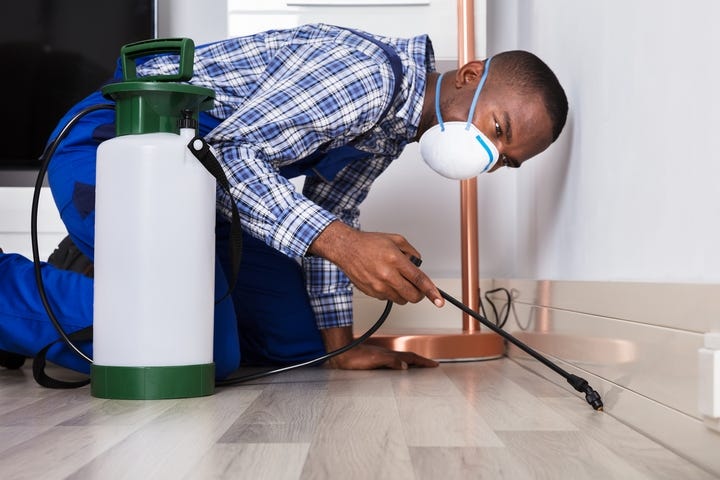Relied on Exterminator Near Me: Your Neighborhood Pest Control Remedy!
Wiki Article
Specialist Parasite Control Techniques for Long-Term Results
In the realm of pest control, attaining sustained efficacy and lasting results requires a meticulous strategy that transcends plain extermination. Specialist insect control techniques encapsulate an extensive approach that starts with an extensive evaluation and assessment, followed by precise bug recognition to understand their actions patterns. The implementation of Integrated Bug Administration (IPM) concepts, coupled with eco-conscious therapies, creates the foundation of lasting pest elimination. Nonetheless, real examination exists in the continuous surveillance and maintenance of the treated locations, ensuring a pest-free atmosphere for the near future. By diving right into the ins and outs of these techniques, a much deeper understanding of professional insect control approaches for sustaining end results emerges.Assessment and Assessment
Upon going into a residential property for parasite control services, the preliminary action is a thorough examination and evaluation to determine the level of the problem and establish one of the most reliable treatment strategy. Expert insect control service technicians are trained to carefully take a look at the facilities, looking for signs of bug task such as droppings, munch marks, nests, or any architectural damages. They will likewise examine the conditions that may be attracting bugs, such as food resources, water leakages, or entrance factors.
Parasite Identification and Habits

Moreover, recognizing the habits of the determined bug is key to applying reliable control measures. For example, recognizing where parasites nest, what they feed on, and their activity patterns can aid pest control professionals devise strategies to eradicate them effectively. Some parasites might be nocturnal, while others are much more energetic throughout the day. This understanding permits the application of treatments at optimal times for optimum performance.
Integrated Insect Monitoring (IPM)
Integrated Pest Monitoring (IPM) strategies integrate multiple strategies to regulate and protect against insect invasions in a sustainable and environmentally pleasant way. Exterminator DC. By integrating approaches such as biological control, environment control, adjustment of cultural techniques, and making use of immune selections, IPM aims to lessen using chemical pesticidesOne of the essential concepts of IPM is the focus on avoidance. This proactive technique entails monitoring bug populaces routinely to identify any prospective problems prior to navigate to this site they rise. By identifying insect issues beforehand, pest control measures can be executed quickly and effectively.
Additionally, IPM advertises the usage of non-toxic pest control methods whenever possible. This can include using all-natural killers of the pests, introducing beneficial insects, or utilizing pheromones to interrupt mating patterns. By informative post minimizing reliance on chemical pesticides, IPM not only secures the setting however additionally aids maintain a balance in the ecosystem.
Environmentally-Friendly Treatments
Implementing eco-conscious strategies in insect control procedures can effectively address infestations while prioritizing ecological sustainability. Environmentally-friendly therapies concentrate on lessening the effect of insect control methods on communities, non-target microorganisms, and human health and wellness. These techniques frequently involve making use of all-natural killers, such as ladybugs or nematodes, to manage pest populations, reducing the demand for chemical treatments. Furthermore, methods like habitat adjustment, such as changing moisture levels or removing food resources, can aid prevent insects without using damaging substances.One more trick aspect of environmentally-friendly therapies is making use of organic and biodegradable items that break down promptly without leaving damaging residues in the setting. Organic insecticides derived from plants like chrysanthemums or neem supply reliable pest control while presenting minimal danger to non-target varieties. Moreover, utilizing methods like warmth treatments or scent catches can target certain insects with accuracy, decreasing the total ecological impact of bug control practices.
Recurring Surveillance and Maintenance
Continual surveillance and maintenance More about the author are essential components of efficient bug control monitoring. Recurring monitoring plays an important function in ensuring that insect invasions are found very early and managed promptly. Regular inspections by trained professionals are needed to determine any type of signs of pest activity, analyze the performance of previous therapies, and make changes to the bug control strategy as needed. By keeping track of insect populations in time, pest control specialists can track fads, prepare for prospective problems, and execute preventive measures to decrease the threat of future invasions.
Along with surveillance, maintenance practices are crucial for long-term bug control success. This includes executing appropriate cleanliness actions to get rid of possible food and water sources for bugs, sealing off entrance points to stop insects from getting in the facilities, and addressing any structural concerns that could help with insect invasions (exterminator). By incorporating ongoing monitoring and maintenance right into an incorporated insect administration approach, businesses can make sure a pest-free setting and guard their building versus costly damage and health and wellness dangers
Final Thought
To conclude, using expert bug control strategies such as detailed examination and analysis, precise parasite identification and understanding of their actions, integrated pest monitoring techniques, environmentally-friendly treatments, and ongoing surveillance and maintenance are essential for accomplishing lasting lead to bug control. By executing these methods, people can successfully manage pest problems and preserve a pest-free environment in a lasting manner.Report this wiki page